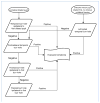Outcomes Following Exploratory Burr Holes for Traumatic Brain Injury in a Resource Poor Setting
- PMID: 28583456
- PMCID: PMC5575971
- DOI: 10.1016/j.wneu.2017.05.153
Outcomes Following Exploratory Burr Holes for Traumatic Brain Injury in a Resource Poor Setting
Abstract
Background: Traumatic brain injury (TBI) is a leading cause of death and disability worldwide. The incidence of TBI in low- and middle-income countries (LMICs) is disproportionately high, with an associated increased risk of mortality from TBI relative to high-income countries. Although computed tomography is the diagnostic method of choice, this is often unavailable in LMICs. Exploratory burr holes may provide a suitable choice for diagnosis and treatment of TBI.
Methods: We performed a retrospective review of prospectively collected data at KCH, a tertiary care center in Lilongwe, Malawi. All trauma patients presenting between June 2012 and July 2015 with a deteriorating level of consciousness and localizing signs and who underwent exploratory burr holes were included. Additionally, we included all patients admitted with TBI, requiring higher-level care during 2011. No patients underwent exploratory burr hole during this time. We performed logistic regression to identify predictors of mortality in the total population of TBI patients.
Results: Among the 241 patients who presented to KCH with TBI requiring higher-level care, the total mortality was 16.4%. More than half (163, or 68%) underwent exploratory burr hole with a mortality of 6.8%. Mortality in patients who did not undergo exploratory burr hole was 43.9%. Upon adjusted logistic regression, not undergoing exploratory burr hole significantly increased the odds of mortality (odds ratio = 12.0, P = 0.000, 95% confidence interval = 4.48-31.9).
Conclusion: Exploratory burr holes remain an important diagnostic and therapeutic procedure for TBI in LMICs. Exploratory burr hole technique should be integrated into general surgery education to attenuate TBI-related mortality.
Keywords: Global neurosurgery; Low- and middle-income countries; Trauma; Traumatic brain injury; sub-Saharan Africa.
Copyright © 2017 Elsevier Inc. All rights reserved.
Conflict of interest statement
Figures
Similar articles
-
Factors affecting mortality after traumatic brain injury in a resource-poor setting.BJS Open. 2020 Apr;4(2):320-325. doi: 10.1002/bjs5.50243. Epub 2019 Dec 19. BJS Open. 2020. PMID: 32207576 Free PMC article.
-
Epidemiology, Management, and Functional Outcomes of Traumatic Brain Injury in Sub-Saharan Africa.World Neurosurg. 2017 Dec;108:650-655. doi: 10.1016/j.wneu.2017.09.084. Epub 2017 Sep 21. World Neurosurg. 2017. PMID: 28943422
-
Survival and Functional Outcomes at Discharge After Traumatic Brain Injury in Children versus Adults in Resource-Poor Setting.World Neurosurg. 2020 May;137:e597-e602. doi: 10.1016/j.wneu.2020.02.062. Epub 2020 Feb 19. World Neurosurg. 2020. PMID: 32084614 Free PMC article.
-
The Burden of Traumatic Brain Injury in Sub-Saharan Africa: A Scoping Review.World Neurosurg. 2021 Dec;156:e192-e205. doi: 10.1016/j.wneu.2021.09.021. Epub 2021 Sep 11. World Neurosurg. 2021. PMID: 34520864
-
Effectiveness of burr holes for indirect revascularization in patients with moyamoya disease-a review of the literature.World Neurosurg. 2014 Jan;81(1):91-8. doi: 10.1016/j.wneu.2013.05.010. Epub 2013 Jun 5. World Neurosurg. 2014. PMID: 23747434 Review.
Cited by
-
Development of a Three-dimensional Printed Emergent Burr Hole and Craniotomy Simulator.Cureus. 2019 Apr 3;11(4):e4373. doi: 10.7759/cureus.4373. Cureus. 2019. PMID: 31218138 Free PMC article.
-
Current trends and challenges: The landscape of perioperative mortality in intracranial surgeries in low- and middle-income settings: A narrative review.Health Sci Rep. 2024 Jan 25;7(1):e1838. doi: 10.1002/hsr2.1838. eCollection 2024 Jan. Health Sci Rep. 2024. PMID: 38274132 Free PMC article.
-
Burr hole as a management for extra axial hematomas in a low-resource setting.Int J Surg Case Rep. 2023 Apr;105:108125. doi: 10.1016/j.ijscr.2023.108125. Epub 2023 Apr 5. Int J Surg Case Rep. 2023. PMID: 37028184 Free PMC article.
-
Serum exosomes miR-206 and miR-549a-3p as potential biomarkers of traumatic brain injury.Sci Rep. 2024 May 2;14(1):10082. doi: 10.1038/s41598-024-60827-8. Sci Rep. 2024. PMID: 38698242 Free PMC article.
-
An evaluation of outcomes in patients with traumatic brain injury at a referral hospital in Tanzania: evidence from a survival analysis.Neurosurg Focus. 2019 Nov 1;47(5):E6. doi: 10.3171/2019.7.FOCUS19316. Neurosurg Focus. 2019. PMID: 31675716 Free PMC article.
References
-
- Injury:a leading cause of the global burden of disease. [Accessed June 17, 2017];Injury. 2000 2000:1–51. Available at: http://www.who.int/violence_injury_prevention/publications/other_injury/...
-
- de Ramirez SS, Hyder AA, Herbert HK, Stevens K. Unintentional injuries: magnitude, prevention, and control. Annu Rev Public Health. 2012;33:175–191. - PubMed
-
- Capone-Neto A, Rizoli SB. Linking the chain of survival: trauma as a traditional role model for multisystem trauma and brain injury. Curr Opin Crit Care. 2009;15:290–294. - PubMed
-
- Gunnarsson T, Fehlings MG. Acute neurosurgical management of traumatic brain injury and spinal cord injury. Curr Opin Neurol. 2003;16:717–723. - PubMed
MeSH terms
Grants and funding
LinkOut - more resources
Full Text Sources
Other Literature Sources
Medical


